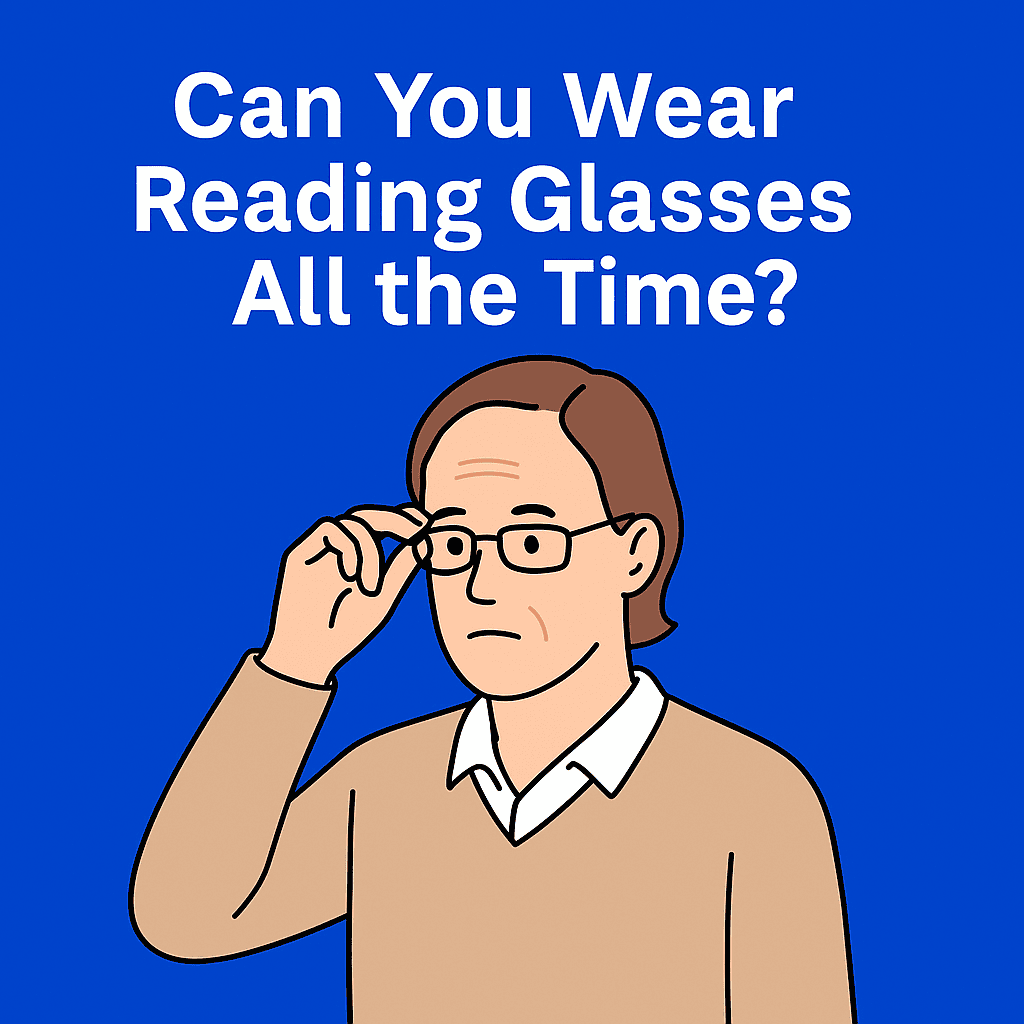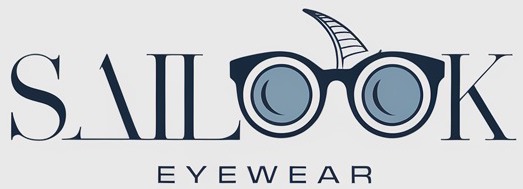Wearing reading glasses is common for those dealing with presbyopia, especially for tasks like reading or checking a phone. But some people go a step further—wearing them all day, even when not reading. This brings up a big question: is it safe or even beneficial to do so?
This article takes a close look at how all-day use affects your vision, your comfort, and your long-term eye health. We’ll also walk through alternatives, recommendations from eye care professionals, and practical tips on how to use reading glasses properly in both work and lifestyle situations.

1. What Happens If You Wear Reading Glasses All The Time?
Reading glasses are designed to enhance near vision, typically for viewing items 14–18 inches away. They do this by using convex lenses that make text or small objects appear sharper. When you wear them for longer than needed—or for tasks not involving near vision—they may become more of a burden than a help.
But here’s the kicker… wearing them constantly won’t harm your eyes permanently, but it does increase the chances of discomfort. Because the lenses magnify your vision, using them while walking around or focusing on something more than two feet away can distort your perception of depth, leading to dizziness or headaches.
It’s like using binoculars to watch a movie up close—your eyes aren’t functioning naturally. The result? Visual fatigue.
Here’s a real-world example. A sales manager in Chicago found herself reaching for her +2.00 reading glasses constantly. At first, it helped with reviewing contracts and reading emails. But within two weeks, she started experiencing frequent temple pain and blurry distance vision. Her optometrist advised limiting use to close-up tasks and switching to progressives for her computer work.
Table 1: Common Effects Of Wearing Reading Glasses All Day
| Effect | Description | Cause |
|---|---|---|
| Blurry Distance Vision | Objects farther than 1–2 feet appear out of focus | Lens magnification |
| Eye Fatigue | Soreness, pressure, or tired eyes | Prolonged visual compensation |
| Headaches | Dull or throbbing pain near eyes or temples | Misalignment or overuse |
| Disorientation | Feeling off-balance or dizzy while walking | Altered depth perception |
2. Are Reading Glasses Meant For Full-Day Use?
Reading glasses serve a very specific purpose: to correct presbyopia during near-vision activities. They’re not designed for prolonged or full-day use.
Here’s the deal… if you try to use them for everything—like working on your laptop, walking through the office, or watching TV—you’ll likely find that they do more harm than good. That’s because reading glasses blur distance vision, and many activities require frequent shifts between close and far focus.
Someone with a visually active lifestyle—like a teacher who moves between reading, lecturing, and writing on a board—would struggle with all-day readers. Instead, optometrists often recommend bifocal or progressive lenses for people needing different correction zones in one frame.
One patient, a freelance writer in Berlin, switched from readers to bifocals after months of discomfort. The improvement was almost instant. She could write, edit, and attend Zoom calls without taking her glasses on and off repeatedly.
Table 2: When Reading Glasses Are Appropriate
| Activity | Should Use Readers? | Why Or Why Not |
|---|---|---|
| Reading books | ✅ Yes | Designed for close-range clarity |
| Using a smartphone | ✅ Yes | Eyes need help focusing at short distances |
| Walking around indoors | ❌ No | Distance vision may be compromised |
| Driving | ❌ No | Can impair distance and peripheral vision |
| Cooking | ⚠️ Maybe | Depends on how much reading is involved |
3. Do Reading Glasses Weaken Your Eyesight?
Let’s bust a myth right away: no, reading glasses don’t weaken your eyes.
Presbyopia, the age-related condition that reduces near-vision sharpness, is a natural process. Wearing glasses neither accelerates nor causes it. What they do is help you see clearly without straining. Without them, you’d squint or overcompensate, potentially causing temporary eye fatigue—but not permanent vision loss.
Still, this is where people get confused. As presbyopia progresses, many assume their vision is worsening because of the glasses. In truth, their natural decline is continuing, and they now need stronger magnification—not because of glasses, but because of age.
What can affect your eyes negatively is using the wrong strength or skipping regular checkups. Using stronger lenses than necessary forces your eyes to adjust in ways they shouldn’t. Over time, that leads to headaches, tired eyes, or a false sense that your vision is deteriorating.
Table 3: Factors That Do And Don’t Affect Eye Strength
| Affects Vision | Doesn’t Affect Vision |
|---|---|
| Aging (Presbyopia) | Wearing reading glasses correctly |
| Using incorrect strength | Wearing glasses for comfort |
| Ignoring eye check-ups | Having multiple pairs of readers |
| Digital eye strain | Swapping between readers and distance glasses |
4. Can Wearing Reading Glasses Cause Headaches Or Eye Strain?
Yes, and it often happens when people choose off-the-shelf glasses without checking if they suit their needs.
Headaches usually result from wearing lenses that don’t match your eye prescription or pupillary distance. Off-the-shelf readers often have symmetrical lenses and a standard PD, which may not work for those with slightly different needs in each eye.
You might be wondering how common this is… Studies suggest that more than 40% of people using generic readers report symptoms like blurry vision, tension, or frequent blinking after a few hours of use.
A marketing executive in Tokyo shared that after using +2.50 reading glasses from a kiosk, she suffered daily headaches. An eye exam revealed her ideal power was +1.75 in one eye and +2.00 in the other—with a narrower PD. After switching to custom lenses, the headaches stopped.
Table 4: Common Causes Of Discomfort With Reading Glasses
| Symptom | Potential Cause | Suggested Fix |
|---|---|---|
| Headaches | Overpowered lenses | Lower lens strength |
| Eye strain | Mismatched left/right lens power | Get custom prescription |
| Blurry vision | Wearing readers outside reading distance | Remove when not reading |
| Fatigue | Prolonged wear with no breaks | Use only as needed |
5. Should You Wear Reading Glasses While Using A Computer?
Not ideally.
Computer screens are typically placed at an intermediate range, not the close-up range that reading glasses are built for. Using readers while looking at a monitor often forces people to lean forward or squint, which can cause neck and shoulder tension over time.
This is where it gets interesting… computer glasses, with lenses designed for that middle distance, solve the problem. They often include blue light filters and anti-reflective coatings as well, making screen time more comfortable.
An IT manager in Austin made the switch after experiencing consistent tension headaches at work. His optometrist created a pair of +1.25 computer glasses (vs. his usual +2.00 reading pair), and within days, the difference in posture and clarity was clear.
Table 5: Comparing Reading And Computer Glasses
| Feature | Reading Glasses | Computer Glasses |
|---|---|---|
| Distance Range | 14–18 inches | 20–28 inches |
| Ideal Use | Books, paperwork | Laptops, monitors |
| Risk of strain | Higher for screen use | Lower for screen use |
| Posture impact | May cause leaning in | Encourages upright posture |
6. What Are The Pros And Cons Of Wearing Reading Glasses All Day?
At first glance, wearing reading glasses all day seems like a practical decision. No need to take them on and off. No need to juggle multiple pairs. Just put them on and go about your day. But there’s more beneath the surface.
Here’s the reality… while this approach may offer convenience, it compromises your vision quality and long-term comfort. Reading glasses are designed to sharpen your near vision only. When worn continuously, they distort your distance vision, impair spatial awareness, and even contribute to physical strain from posture compensation.
The pros? Sure, they’re quick to use, easy to replace, and often available without a prescription. If you spend hours on paperwork, sewing, or reading, leaving them on might make sense. Some people also enjoy the aesthetic, treating reading glasses as part of their daily style.
The cons outweigh the convenience for most users. Wearing magnified lenses when not needed confuses your visual system. It makes basic tasks like walking or reading signage uncomfortable or even unsafe. A graphic designer in Amsterdam shared that she used to wear her stylish readers all day—until she missed a step on the stairs because her depth perception was off. After switching to progressive lenses, her productivity and safety improved dramatically.
In short, readers serve best in bursts. Using them beyond their range invites more issues than benefits. Know the limits of your eyewear and choose function over convenience whenever possible.
7. When Should You Start Using Reading Glasses?
Presbyopia doesn’t arrive all at once. It creeps in slowly, often becoming noticeable between ages 40 to 45. The first signs are subtle—you might stretch your arm to read a menu or turn up the brightness on your phone just to make out a text message.
So, when should you actually start using reading glasses? The answer: when you consistently struggle with near tasks. Occasional blurring isn’t a sign just yet, but repeated squinting, headaches after short reading sessions, or needing more light to see clearly all point to an emerging need.
But don’t self-prescribe blindly. A professional eye exam ensures you’re choosing the right lens power and checks for early signs of other conditions like cataracts or glaucoma.
Take the case of a banker in Paris. He noticed he had to squint at spreadsheets by mid-afternoon. Thinking he needed glasses, he grabbed a pair of +2.00 readers at a pharmacy. It helped a little, but also gave him nausea. An optometrist later confirmed he only needed +1.00 and had a slight astigmatism in one eye—which off-the-shelf glasses couldn’t address.
The takeaway? Start when your eyes tell you, but verify your choice with an exam.
8. Can You Wear Reading Glasses Even If You Don’t Need Them?
It might sound harmless—throwing on a stylish pair of reading glasses even if you don’t need magnification. But depending on the lens, it could do more harm than you expect.
Here’s what happens… if you wear magnified lenses without requiring them, your eyes will try to adjust to an unnecessary correction. That can result in blurry vision, tension, or dizziness, especially if you move around while wearing them.
However, if your frames have zero-power lenses (often called “plano” lenses), you’re fine. These are purely aesthetic and don’t interfere with your vision. Many fashion-forward users opt for clear lenses with blue-light filters or anti-reflective coatings to look sharp while working at a computer.
An advertising executive in Seoul loved the intellectual look of readers. He wore a +1.50 pair daily—even though he had perfect vision. After a week of mild headaches and an odd sense of imbalance, he learned the mistake. Swapping to non-prescription lenses gave him the same look without the side effects.
In summary, wear glasses for style—but not at the cost of your vision. If you want the look, go plano. If you need magnification, get a proper fitting.
9. How Do You Know If You Need Stronger Reading Glasses?
Reading glasses are not one-and-done solutions. Just like your body changes with age, your eyes do too. Over time, your initial +1.00 might not cut it anymore.
But how can you tell if it’s time to upgrade? A few signs include:
- Having to hold reading material farther away
- Needing brighter light than usual
- Rereading lines or squinting after just 10–15 minutes
- Getting more frequent headaches during close-up work
A textile buyer in Copenhagen noticed that her usual glasses felt “off” during fabric inspections. Textures weren’t as sharp, and she had to lean in to catch small details. Her optometrist upgraded her from +1.50 to +2.00, and the strain disappeared.
Diopter strength generally increases by +0.25 or +0.50 every few years. But don’t guess. Use near vision charts at home for a quick check, and get a proper refraction test at least every two years.
Your eyes are worth the investment.
10. Are Prescription Reading Glasses Better Than Store-Bought Ones?
In short—yes, they are. And here’s why.
Over-the-counter reading glasses are mass-produced. They come with equal strength in both lenses and a standard pupillary distance. But most people have slight variations in each eye. That’s where prescription readers make all the difference.
Let’s break it down. Prescription readers are tailored not just to your diopter strength, but to your exact eye alignment, astigmatism, and visual behavior. They include coatings for anti-glare, UV protection, or even transitions if needed.
Think of it like buying shoes. Store-bought readers are the equivalent of wearing generic insoles. They’ll get you through the day—but they won’t support you where it counts.
A web developer in San Francisco experienced constant blur with his +1.75 readers, despite being the “right” power. His optometrist measured a 2mm PD difference and mild astigmatism in his dominant eye. A custom prescription fixed the issue in a heartbeat.
If you’re wearing readers for more than 30 minutes a day, investing in prescription versions could mean the difference between comfort and constant irritation.
Conclusion
Wearing reading glasses all the time might feel convenient—but convenience often comes with hidden costs. These glasses are built for specific near-vision tasks, and stretching their use beyond that can compromise clarity, posture, and eye comfort. Misuse might not damage your eyesight permanently, but it certainly affects your quality of life.
By understanding when, why, and how to use reading glasses effectively, you can protect your vision, reduce fatigue, and maintain sharp focus where and when it’s needed most. The smarter choice is to use readers only when necessary—and explore professional solutions like bifocals, progressives, or custom prescriptions for more dynamic vision needs.
Take control of your visual comfort. Listen to your eyes, and let clarity guide your decisions.
FAQ Section
- Q1: What are reading glasses?
Reading glasses are magnifying lenses designed to help people see things up close, especially when their eyes naturally lose focusing ability with age. - Q2: How does magnification in reading glasses work?
It bends light to help your eyes focus better on near objects, compensating for the loss of elasticity in the eye lens due to aging. - Q3: Can I wear reading glasses for everything I do in a day?
In most cases, no. Reading glasses are optimized for close-up tasks and may blur your distance vision if worn constantly. - Q4: Will my eyes become dependent on reading glasses?
Not truly. They don’t change your eye structure but using the wrong strength can lead to discomfort and strain. - Q5: What’s the difference between over-the-counter and prescription reading glasses?
Prescription glasses are customized based on your exact eye measurements, while over-the-counter ones use standard magnification without accounting for eye differences.

